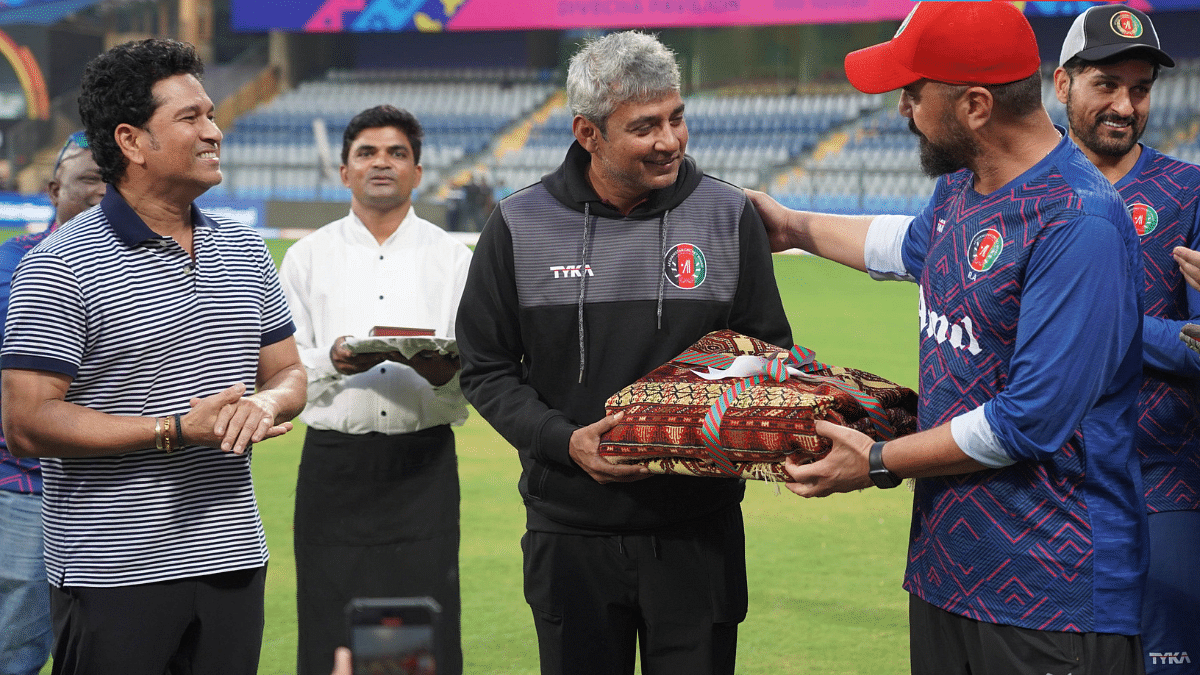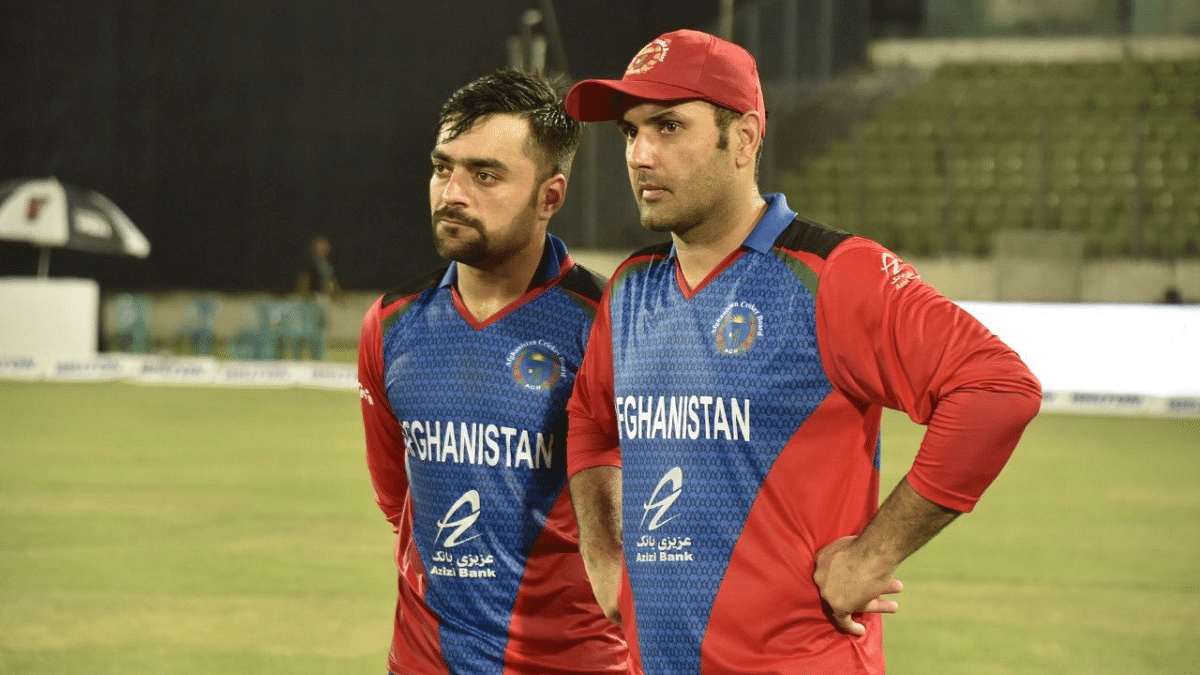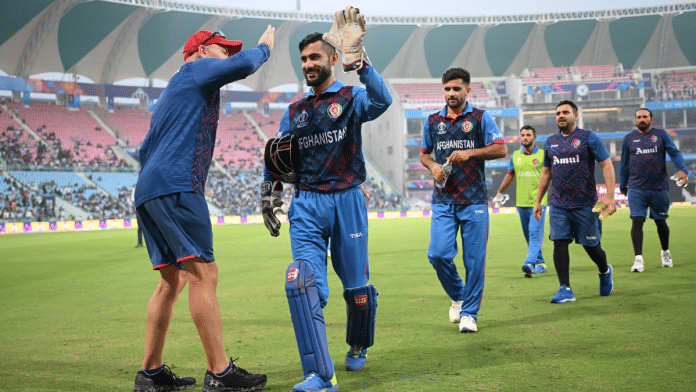New Delhi: “Maine kuch nahi kiya. Main toh tourist hun; guide hun. Pyare log hain. Yeh dekh rahe ho? (My contribution is nothing. I am a tourist; a guide. They are lovely people. Are you seeing this?” Ajay Jadeja was talking about the Afghanistan cricketers smearing the cake on their captain Hashmatullah Shahidi’s face after the seven-wicket win over the Netherlands in the World Cup in Lucknow.
Jadeja, a former India ODI captain and mentor of the Afghanistan team for the World Cup, and the Afghan cricketers had just returned to the hotel to loud drum beats. A tastefully prepared cake by the hotel, with ‘Congratulations’ written over it, awaited the team in the hotel lobby.
Shahidi tried to escape his teammates, but was overpowered. Within seconds after that, Jadeja and the delirious players disappeared into their rooms, leaving the hotel staff to clean the floor.
It was Afghanistan’s fourth win in seven matches, the vanquished included three previous winners — defending champions England, Pakistan, and Sri Lanka. The win over the Netherlands gave the hope of making it to the World Cup semi-finals for the first time. Although they eventually failed, Afghanistan left an indelible imprint on the tournament — and the promise of better performance in the future.
Afghanistan’s incredible 22-year journey in top class cricket, since being granted affiliate membership by the International Cricket Council (ICC) in 2001, is eventful, to say the least. It has been interspersed by an overlapping of the sport and politics. But cricket has overcome all hurdles and setbacks, and survived in the war-ravaged country.
An unforgettable World Cup
Afghanistan cricket bloomed like never before in the World Cup, as they demolished the three former champions exceeding everyone’s expectations, perhaps their own as well. In all, they won four of their nine league matches, but missed the semi-finals by a whisker. They finished sixth with eight points, the same as the fifth-placed Pakistan, but had a slightly inferior net run rate.

“Credit to the players on how they have come out, reacted, and played. They have done really well. They are a very good team; they had a very strong bowling line-up. But batting is now their main strength and it has helped them punch above their weight. No one gave them a chance to come close to the semi-finals. They have lifted their game and the challenge would now be to go forward and play matches with the top five-six teams regularly,” former India all-rounder Irfan Pathan, who helped Afghanistan hire India’s Milap Mewada as batting coach for the World Cup, told The Print.
Afghanistan’s litmus test came in the match against Australia, as they needed a win to brighten chances of a semi-finals berth. But Glenn Maxwell, with his astonishing double century, poured water on the aspirations of Shahidi’s team.
“Afghanistan should have played one more fast bowler. They should not have left Fazalhaq Farooqui out. Bowling at night at Wankhede can get tough, and here you need a fast bowler. Obviously, that [picking four spinners] was a tactical mistake. When you go in with that strategy, you want the spinners to squeeze the opposition and that didn’t happen. And, fielding let them down at crucial junctures. Also, Afghanistan got pretty excited,” Pathan said.
The defeat meant that Afghanistan needed to beat South Africa in their last league match and pray for other results to go in their favour. But that didn’t happen. For the time being, they have to be content with the $260,000 prize money won in this tournament.
Also Read: Cricket in Kashmir has always had a troubled pitch. Now women are helping change the game
Journey so far
Established in 1995, the Afghanistan Cricket Federation — later known as the Afghanistan Cricket Board (ACB) — became an associate member of the Asian Cricket Council in 2003. It was made an affiliate member, the third and the lowest rung, by the ICC in 2008, followed by associate membership in 2014, before getting the full Test status in 2017.
Afghanistan earned the official ODI status in April 2009, and in 2015 they qualified for the 50-over World Cup, hosted in Australia and New Zealand. The 2023 World Cup was their third, having also competed in the 2019 edition in England.
Afghanistan have qualified for the T20 World Cup seven times, starting 2012, including the next year’s tournament in the West Indies and the US. “The game development in the country is unique. The increasing number of cricket clubs and registered players is making the context very much inclusive. The grounds and academy development has made the game accessible to the youth in the country,” the ICC says.
Although funds are an issue, both the ICC, through its funding of developing nations, and India have done their bit. “The cricket boards and governments of the two countries have good relations, and we will try to maintain this friendship,” Azizullah Fazli, a former ACB chairman, said in 2019. This, coupled with assistance from successive Afghanistan governments, has helped the ACB to develop infrastructure, though the facilities still need a lot of improvement.
Afghanistan’s journey to their recent World Cup success has an important stop – India. In 2015, the ACB signed an MoU with the Board of Control for Cricket in India (BCCI), and the Greater Noida Industrial Development Authority to use Shahid Vijay Singh Pathik Sports Complex as its ‘home ground’. They also organised camps/training sessions in Bengaluru and Chennai, besides playing bilateral ‘home’ international matches in Dehradun, Lucknow, and Greater Noida.
Afghanistan players found a home-like atmosphere in Dehradun. While staying there, they also went to Mussoorie and Manali for river rafting in 2018. They also feasted on Indian cuisine. Their ‘home series’ against Bangladesh in Dehradun coincided with Ramadan, and their hotel took special care of the fasting cricketers. The weather suited them perfectly.
“In places like Jalalabad and Kandahar, the weather is exactly the same as in Dehradun. So, we can’t make out if we are playing in Afghanistan or Dehradun. It is very advantageous for us,” then captain Asghar Afghan said during their series against Ireland in 2019.
After their MoU with India expired, the ACB were in talks with the BCCI for extension when the Corona pandemic in 2020 stopped all activities, said a source.
The other ‘homes’
Since various national teams have declined to tour Afghanistan — partly due to security reasons and partly due to a lack of sufficient infrastructure — the ACB has been organising the team’s training camps and playing matches around the world. They have played bilateral international matches in Sharjah, Greater Noida, Dehradun, Lucknow, Abu Dhabi, and Colombo and Hambantota in Sri Lanka.
In 2010, the Sharjah Cricket Stadium became their base. The ACB signed an MoU with the Pakistan Cricket Board in 2013 for ‘fast track’ development of Afghanistan cricket ahead of the 2015 World Cup, where they registered their only win over Scotland.
Under this agreement, the Afghan team trained at the National Cricket Academy at Lahore’s Gaddafi Stadium while some players, like ace off-spinner Mohammad Nabi, also participated in Pakistan’s domestic tournaments and the Pakistan Super League.
Also Read: How India’s guiding hand helped lift up Afghanistan cricket. England shocker is latest example
Journeymen cricketers
Despite the hardships and the disadvantage of not having the home advantage, Afghanistan cricketers have stayed afloat. Many of them have been plying their trade in the various T20 leagues – from the Indian Premier League to The Hundred in England.
For example, Nabi, their senior most national cricketer, has represented at least 20 teams in all the major T20 leagues while leg-spinner Rashid Khan, the most recognised Afghan cricketer, has played for at least 14 teams. Both middle order batsman Najibullah Zadaran and pacer Naveen-ul-Haq have featured for 12 T20 sides, including a couple in the Pakistan Super League, while wicketkeeper-batsman Rahmanullah Gurbaz has turned out for 11.
These T20 leagues have given them the opportunity to earn some money and improve lifestyle. Jodhpur-based commentator Devender Kumar, who has been visiting Afghanistan to cover cricket for radio and TV for six years, has seen the change from close. “After getting into the various leagues, many cricketers’ lifestyles have changed.”
In spite of exhibiting – and exposing — their skill around the world, these players haven’t lost their sharpness – notwithstanding video analysts, who bisect every aspect of the game. “Video analysis helps you get an idea, create a film in the mind, of bowlers and batsmen. You’ve to fight the battle on your own in the field,” Rashid said a couple of years ago. “For example, Virat [Kohli] bhai is making a lot of runs and everything. And there are many video analysts, who are analysing that he is weak here or there, but he is still playing his cover drives as usual. If everyone has assessed his strong points, why then bowlers pitch the ball in the area from where they are hit?”
Another source of income for the local cricketers is the popular variant of the game — tape-ball cricket. It is very popular, particularly in Afghanistan’s provinces. And decent prize money could also be earned from it and that acts as a morale booster for youngsters.
“In the recently concluded Afghanistan Tape Ball Cricket League, we gave 1,000 Afghani (Indian Rs 1,200 approx) to the man of the match and 10,000 Afghani (Rs 12,000) to the man of the tournament. Twenty of the 33 provinces play tape-ball cricket. In the tournaments played at the provincial level, the winning team gets 10,000 Afghani,” Afghanistan Tapeball Cricket (ATC) president Sheer Rahman Khater told The Print. “ATC is registered with our national sports ministry and also with the International Tapeball Cricket Council.”
Apart from earning their livelihood from cricket, at times Afghanistan players assist their families run business. Some of these businesses involve dry fruits and gems, while others are into agriculture and animal husbandry, says Devender Kumar. “Some years ago, captain Hashmatullah Shahidi had told me that his father is an academician and that he has written 44 books. Some other players’ families are into business,” he informs.
The Taliban factor
Cricket is one of the sports that Taliban has allowed to be played since taking over the reins in August 2021. Among the other sports that continue to be played are football, karate, volleyball, and the national sport buzkashi. But the women’s cricket team has been barred. This triggered a crisis as Cricket Australia unilaterally cancelled a scheduled three-match ODI series in March in the UAE, though Australia played Afghanistan in the Twenty20 World Cup last year (and just managed to avoid defeat). The ACB said it was “extremely disappointed and saddened by the pathetic statement” of Cricket Australia.
No one is willing to talk openly about the restriction on women’s cricket in Afghanistan. A source, however, said that Afghans were angry at Australia’s decision. “People took the series cancellation as an affront and the men’s team apparently vowed to defeat Australia in the World Cup in India, though that didn’t happen,” he said. “It is said that talks are on between the Taliban government and the ACB over the issue of women’s cricket, raising hopes.”
Significantly for Afghanistan, the ICC hasn’t stopped the funding. This decision is consistent with its policy of not reprimanding/penalising a member country when politics overrule the concerned national cricket board, like it happens with India-Pakistan bilateral cricket.
India and Pakistan have not played bilateral cricket for almost 11 years, and the ICC Future Tours Programme (2023-2027), too, doesn’t include any bilateral series between them. But the ICC has not taken any punitive action. India and Pakistan have, however, always played against each other in ICC tournaments.
Winning hearts before heartbreak
Maxwell was single-handedly responsible for Afghanistan’s defeat in the World Cup, as he smashed an unbeaten 201 off just 128 balls to help his team overhaul the 292-run target, made possible by opener Ibrahim Zadran’s brilliant unbeaten 143-ball 129 – the first Wold Cup ton by an Afghan. Maxwell batted for a long while with cramps. Afghanistan’s inexperience showed as they failed to bowl tactically to the injured Maxwell.
Pathan blames the team selection for the loss. “When it comes to having experience and holding the nerve, Afghanistan will get better with time,” he predicts.

·
Afghanistan, who always bank on world class spinners like Rashid Khan and Mohammad Nabi, showed a much improved batting performance. This was starkly evident in six of the nine matches where Afghanistan raked up 240-plus totals. Two of these totals were made while batting second in winning causes.
Pathan credits Mewada, a former India Under-19 player, for turning Afghanistan’s batting unit around. “He worked with them for four-five months before the World Cup. And if you see the difference in their batting, it’s difficult to believe. All the guys, starting with Rahmat Shah, love and respect him as they know he works really hard. Milap’s good work has gone unnoticed, though.”
Afghanistan’s batting flopped in just two matches – against Bangladesh and New Zealand – and that eventually cost them a spot in the semi-finals.
Mewada said he could not comment as he is still under contact with the ACB. The other Indian – apart from Jadeja – who formed a part of Afghanistan’s support staff was the head physiotherapist, Dr Prasanth Panchada, who has been with the team for a couple of years.
The road ahead
Pathan says Afghanistan need to play a lot more matches to gain experience and strength. “The challenge for teams like Afghanistan is to go to the next level and to be a dominating Asian side. First of all, they need to have a home base where they need to play matches where they could have the advantage of familiar conditions and pitches, like other countries have, where their spinners could come into play. This home base could be anywhere – it could be the UAE – and identified with the help of other national cricket boards,” he says.
“Going forward, the other boards would play a huge role in Afghanistan’s development and progress. Maybe they can sign an MoU for five or ten years. If that happens, it would do a world of good to Afghanistan. It will be very, very crucial — utmost important for them to have a home away from home, as they can’t play in Afghanistan at present.”
Some good news came immediately after the World Cup. Afghanistan will play a three-match T20 series in India in January. Hopefully, for Afghanistan this will be the start of many more series against the established teams.
The writer is a journalist based in Delhi and has covered cricket for three decades. He tweets at @AlwaysCricket
(This is an updated version of the report.)
(Edited by Tony Rai)






